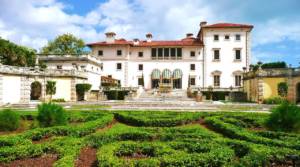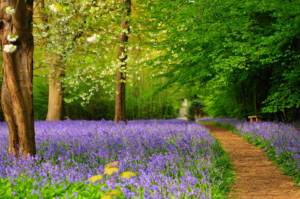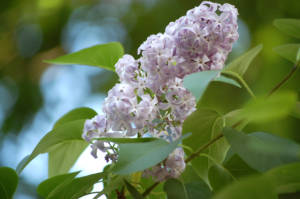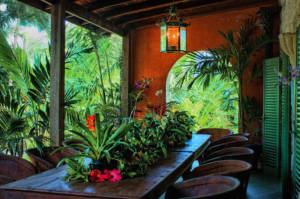6 Gardens Worth The Detour
If you have plans to hit a major tourist destination this year, why not step off the beaten path by visiting a glorious garden-– a great spot for a hike, a five-senses feast, or an impromptu picnic? Here are six gorgeous stops that are worth the detour:
If you’re headed to San Francisco…
The Gardens of Alcatraz have defied all odds. Before 1860, scrawny native grasses and shrubs grew on the windswept island of Alcatraz, located just off the coast in the San Francisco Bay. When the legendary Army fortress became a military prison in 1861, the military planted a few Victorian-style gardens on the summit.
In 1933, when the Federal Bureau of Prisons took over Alcatraz, Freddie Reichel, Secretary to the Warden, talked his boss into letting several prisoners take care of the gardens under the guard tower. Being a blustery location with poor soil and little water, no one thought a garden could ever thrive.
Undaunted, Reichel and his inmate gardeners planted flowerbeds, hillside terraces, and a rose garden. Prisoner Elliott Michener built a toolshed and a greenhouse with salvaged materials and ordered hundreds of seeds and bulbs. The island’s rugged western-facing front bloomed defiantly until 1963, when the final clang of its prison cell doors signaled the end of an era.
The Alcatraz gardens were deserted for 40 years, until the Garden Conservancy and Golden Gate National Parks Conservancy revived the now-overgrown beds and plots, honoring a century’s worth of gardeners on The Rock.
Today, the Gardens of Alcatraz see 1.5 million visitors each year, with many exploring the Rose Terrace, Officer’s Row, and other plants from around the world. Don’t miss hiking on the Agave Trail, where lush foliage and tide pools abound.
If you’re headed to Fort Lauderdale…
Tired of lounging on the beach? Just 10 minutes from the downtown core lies one of the city’s best-kept secrets: the Bonnet House Museum & Gardens, a native barrier island habitat between the Atlantic Ocean and the Intercoastal Waterway. Built in 1920 by Chicago-born artist and art collector Frederic Clay Bartlett, the elegant 35-acre European-inspired subtropical estate is awash with old-world charm. Featuring five ecosystems, a Desert Garden, a maritime forest, a hibiscus garden and one of the largest collections of orchids in the Southeast, the grounds offer a visual and sensory feast that pays tribute to historical Old South Florida. Don’t be startled by the Amazon parrots or the spirited Costa Rican squirrel monkeys frolicking in the trees.
If you’re headed to London…
About an hour outside the city, tucked between the Kent and Sussex borders in the Weald village of Rolvenden, a walled and wonderful English country garden awaits. Hole Park Gardens, a 200-acre property that has been owned by the Barham family for four generations, has majestic topiaries, massive swaths of rhododendrons, azaleas and bluebells, an Italian mirror pond, woodland plants, and sprawling meadows. Hole Park’s 15-acres of finely-manicured lawns, statues, planted urns, clipped yew hedges and both formal and natural gardens are meant for leisurely exploration. One of the owners or the head gardener gives guided tours for those who want to hear the stories behind the stunning herbaceous borders, which were designed and planted by Colonel Barham, great-grandfather of the current owner.
Hole Park’s gardens are open throughout the spring, when visitors are treated to cascades of camellias, wisteria, magnolia, and daffodils, with some additional dates in summer and autumn– just in time to see trees that were planted with Fall foliage in mind.
If you’re headed to Niagara Falls…
If you’re headed to Paris…
Just a couple of miles away from the iconic Eiffel Tower – between Saint-Germain-des-Prés and the Latin Quarter-– sits the Jardin du Luxembourg (known to locals as the ‘Luco’), an urban sanctuary created in 1612 by Marie de’ Medici, the widow of King Henry IV of France. Covering 23 hectares, the grounds were inspired by the Boboli Gardens in Florence and feature tree-lined promenades, more than 100 sculptures, model sailboats floating in a huge circular Grand Bassin, and the iconic Medici Fountain, which was built in 1620.
Luxembourg Garden’s landscape is split into French and English gardens, with a geometric forest and pond in between. An apple orchard, chestnut groves, an apiary, a rose garden, and several greenhouses bursting with orchids make this an ideal place to spend an afternoon. A varied cultural program offers free outdoor photography exhibits and concerts.
With tennis courts, a marionette theatre with live shows during the summer, and a large children’s play area with a carousel, this is a great spot for a family picnic. Green metal chairs from the 1920s are dotted throughout, so no need for a blanket!
If you’re headed to Barbados…
Staying in the bustling Holetown or St. Lawrence Gap areas of the island? Take a half-hour drive to Hunte’s Gardens, named for renowned horticulturalist Anthony Hunte. Located in the center of a rainforest in the hills of St. Joseph’s parish, plants grow all over the place – from way up high, to the deepest, darkest parts of the Caribbean jungle. Many mini-gardens filled with exotic plants and fruit trees make this an ideal place to spend a non-beach morning.
Wander the paths through the beautifully-landscaped gardens in this naturally formed gully, where antiques and statues mingle with rare exotic plants, local birds, and animals. A soothing soundtrack of classical music floats in the air. Hunte himself is often on the property, and is considered one of Barbados’ most colorful characters, always happy to share some stories and a glass (or two!) of rum punch.








































